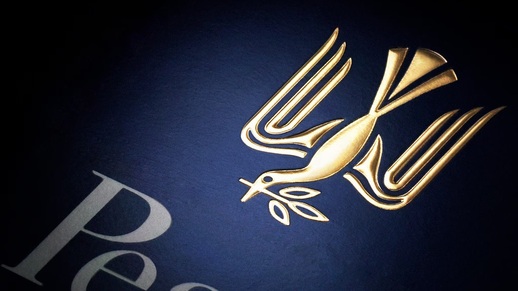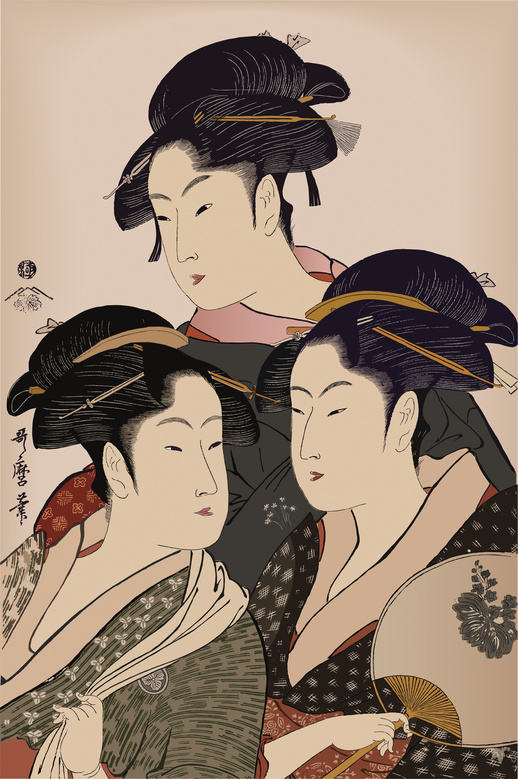2024.08.22
伝検通信(メルマガ)週刊メールマガジン「伝検通信」 第20号
週刊メールマガジン「伝検通信」第20号をお届けします。
今号のトップ記事は、伝統色の研究から生み出されたデザインの話題です。
「クイズで肩慣らし」は前回クイズの答え・解説と、建築・庭園・美術分野からの出題です。
メルマガ登録した方の中から、抽選で100人に公式テキストをプレゼントするキャンペーンも今月末まで引き続き実施中です! 残り10日間です。ぜひお近くの方に本メルマガ登録をご案内ください。
伝検公式テキスト
https://bookpub.jiji.com/book/b648563.html
目次
・ 宙ちゃんの「伝統文化一直線」 第10回 「ピー缶」に込められた思い
・ 「クイズで肩慣らし」第20回(建築・庭園・美術)=「浮世絵」
・ 伝検協会だより
宙ちゃんの「伝統文化一直線」 第10回 「ピー缶」に込められた思い
近藤宙時=日本伝統文化検定協会理事

日本の伝統色である藍色が用いられた「ピース」のパッケージ。
デザイナーのレイモンド・ローウィ―が指定した藍色は、当時の印刷技術では再現が難しく、
新たな樹脂型インクを開発して商品化にこぎ着けたという。
最近とんと耳にしなくなった言葉に「ピーカン晴れ」があります。昭和の頃は、雲一つない晴天を表す決まり文句でした。語源には諸説ありますが、「ピース」という缶入りたばこ(ピー缶)の藍色のパッケージのように深く晴れ渡った空を、いつしかそう呼ぶようになったともいわれています。
この印象的なパッケージをデザインしたのは、フランス生まれでアメリカを本拠地として活躍したレイモンド・ローウィー。工業デザインの概念を打ち立て、工業デザイナーという職業を確立した人物です。日本での知名度はピカソやゴッホに比べるとはるかに低いと思いますが、死後40年近くを経た今の日本でも、彼の作品を見たことのない人は恐らくいないと思われるほどのデザイン界の巨人です。ピースのほか、「F」の筆記体の渦巻きが特徴的な不二家のロゴマークをはじめ、「カナダドライジンジャーエール」、石油ブランドの「エクソン」や「シェル」など、現在も多くの作品が使われ続けています。
彼がピースに関わることになったきっかけは1951年、戦後復興を目指していた日本の経済界から招かれて東京都内で行った講演でした。「日本には資源が無い。従って、好むと好まざるとにかかわらず、原材料を輸入し、製品を作る加工貿易を行うしかない。日本は物まねをするのにたけているが、何よりも大切なことは、物まねをしないことだ。まねをすれば、利益は出ない。個性的なデザインこそが、製品が選ばれる理由であり、付加価値の源泉である」
実に本質を捉えた言葉だと思います。どんなに先進的な機能であっても、いずれは陳腐化します。その時、人がその製品を選ぶのはデザインが決め手になるのが自明の理だからです。 ローウィーの言葉に感銘を受けた日本専売公社(現日本たばこ産業)の総裁が、彼に直談判して生まれたのがピースの新しいパッケージでした。
この講演はその後、日本インダストリアルデザイン協会の設立につながるなど、日本に工業デザインの重要性を認識させるきっかけともなりました。しかし、彼の言葉を肝に銘じ、実践したのは、専売公社や不二家、それに朝日麦酒(現アサヒビール)の経営層ぐらいで、多くはなかったようです。実際、高度成長期から現在まで、日本の製品はどこか他国、他社の製品に似通ったデザインが少なくありません。これこそが、欧米先進国に追いついた後、日本経済が長い低迷期に入り込んでしまった大きな原因の一つだと、私には思えます。
彼は講演で、次のような言葉を付け加えています。「幸い日本には、長い歴史に培われた個性的で大変魅力的な伝統文化がある。これに拠(よ)れば、必ず世界に通用する独自の製品を生み出せるだろう」と。
彼はピースのパッケージをデザインするに当たって、日本を象徴する色を求め、日本の伝統文化に触れるため京都を旅し、奈良時代に冠の色で役人の地位を区別した冠位十二階まで研究したといわれています。専売公社が支払ったデザイン料は内閣総理大臣の月給が11万円の時代に150万円という破格のものでしたが、ピースの売上高は年間26億本から150億本へと激増しました。彼は、講演での自らの言葉を文字通り実践してみせたのです。
彼のために付記するなら、当時の日本で高額ぶりが騒がれた150万円というデザイン料も、当時の為替レートでは4000ドル強にすぎません。1940年に「ラッキーストライク」というたばこのパッケージデザインで5万ドルを受け取った彼からすれば、日本の復興支援のための超サービス価格だったと言えるでしょう。
ともあれ、彼の言葉の通り、長い歴史に培われた日本の伝統文化は、21世紀のデザイン界でも枯れることのない源泉足り得ると思います。直接は無関係のように見える自動車業界や家電業界を含め、日本の製造業から商業・サービス業まで、産業界に従事する全ての方々に伝検を受けてもらえたら、きっと世界を魅了する製品・サービスがもっともっと生み出されるに違いありません。一人でも多くの方の受験を心から願っています。
「クイズで肩慣らし」第20回(建築・庭園・美術)=「浮世絵」
~伝検公式テキスト(9月20日先行発売予定)のジャンルごとに出題します~

喜多川歌麿 「寛政三美人」の模写
第20回
問題:江戸時代の浮世絵師・喜多川歌麿による美人画で、涼やかな夏の浮世絵として思い浮かぶ「寛政三美人」。これを出版、販売した版元は誰でしょう。
【前回の答えと解説】
問題:高校野球の夏の甲子園大会が始まりました。応援スタンドでは、「必勝」と書かれた大きなしゃもじを掲げて応援する高校生の姿もよく見かけます。このしゃもじ(木製)の発祥の地といわれ、生産量が日本一の都道府県はどこでしょう。
答え:広島県
解説:一般的な形のしゃもじは日本三景の一つ、広島県の宮島(厳島)が発祥の地とされています。厳島神社の建立で招かれた宮大工らに由来する宮島細工の名産品で、同県は日本一の生産量を誇ります。しゃもじは、打ち鳴らした時に「カチカチ(勝ち勝ち)」と鳴る音や「敵を召し(飯)取る」の語呂合わせなどから、必勝祈願の縁起物となったといわれています。
伝検協会だより
▼伝検の2級受験者向けにオンデマンド配信講座(有料)を制作中です。その一つとして、弊会の近衞忠大会長、外舘和子、白洲信哉両副会長による鼎談(ていだん)を8月某日、収録しました。伝統文化の楽しみ方や工芸品の鑑賞ポイント、さらには日本人独特の食器へのこだわりなど盛りだくさんの内容で、3人のトークは伝統文化の価値を学びたい方には必見です。また、動画には織部焼の破片を呼び継ぎという技法でつなぎ合わせた徳利(とくり)や志野焼の酒器など、貴重な美術品も登場します。
オンライン講座はこのほか、外舘副会長による「伝統工芸とは何か」、常磐津節演奏家の鈴木英一氏による「伝統芸能の楽しみ方」なども制作、9月下旬に公開予定です。
▼先日、松竹の歌舞伎座タワー(東京・東銀座)で行われた、こども歌舞伎「贋作桃太郎 百桃(もももも)かたり」の公演を見てきました。歌舞伎脚本家・戸部和久さんのオリジナル作品で、日本舞踊家の藤間勘十郎さんが演出・振付を手掛け、道具や衣装も本物を使った本格的な作品でした。舞台の場面転換では、「あおり」と呼ばれる手法を使用。絵本のページをめくるように、背景を折り返すと、御殿の場面が華やかな桃園の場面に変わりました。100人を超える観客全員が、伝統芸能に真剣に取り組む子どもたちの姿に魅了されました。
編集後記
伝検通信第20号をお届けしました。冒頭でも触れた通り、今月末まで本通信に登録された方に公式テキストのプレゼントキャンペーンを実施しています。伝統工芸・伝統文化が網羅的に学べる格好のテキストブックです。故(ふる)きを温(たず)ねて新しきを知る、と今号の「宙ちゃん」連載を読んで、改めて思いました。私も早く公式テキストを手に取りたいとワクワクしています。
カテゴリー: 伝検通信(メルマガ)





